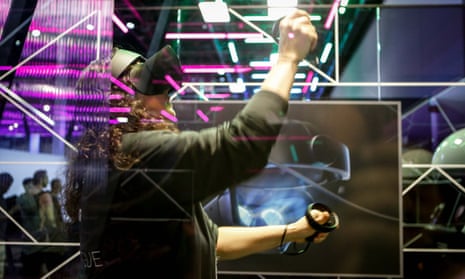Venture capitalist Matthew Ball first wrote about the metaverse in 2018 and his essays have become essential reading for entrepreneurs and tech watchers who are attempting to understand or profit from the network Mark Zuckerberg and many others are anticipating will supersede the internet. Ball is former head of strategy at Amazon Studios and his first book, The Metaverse: How It Will Revolutionize Everything, is published later in July.
What is the metaverse?
It is a persistent network of 3D spaces. Almost everything online today – all applications, digital operating systems, webpages – works on common protocols and technology that connects them. The metaverse is a 3D elevation of the online world, which spans augmented reality – unseen virtual simulations in the world around us – as well as much of consumer leisure and socialising.
So the metaverse doesn’t imply virtual reality (VR)?
I think it’s important to separate access devices and specific experiences from the metaverse at large. A good analogy would be to talk about the mobile internet: apps are not the mobile internet. Not only can you access the mobile internet from a web browser, but you can do so without any visual interface at all. You can say: “Hey Siri, what time is it?” and you’re accessing the mobile internet from your phone. VR or AR (augmented reality) headsets may be a popular way to access the metaverse, but they are not a prerequisite.
Would you describe anything that exists today as a metaverse?
The closest examples would be consumer leisure-oriented gaming platforms such as Minecraft or Roblox: popular experiences reaching tens of millions of people daily, that are tightly integrating millions of different virtual worlds. But that’s still quite modest and it would be a little bit like characterising a GeoCities or Yahoo or AOL portal from the 1990s as a manifestation of the internet as we know it today.

Taking it back even further than Minecraft, online virtual world Second Life is often held up as a proto-metaverse. What distinguishes it from the real thing?
It is a good example. Second Life points to the fact that this is not a new idea. In my book, I talk about the fact that the term comes from 30 years ago, but the theory and early literature around it spanned nearly a century. Second Life was an early, and one of the most important and successful, examples of it; it had a relatively free-standing economy where users could make transactions between one another paying a tax rather than being intermediated by the platform. It was designed around unstructured play, there was no game objective. It was about what you wanted to do and express with the people around you.
But what’s also important is comparing it with today. Second Life at its peak around 2006 had a few million monthly users. It’s quite possible that right now Roblox has more on the platform. Part of that reflects substantial improvements in the ease of creation: we’ve gone from something that amateur and professional hobbyists can do to something that an infant can do. And so in Second Life, we see not just the lineage of the metaverse, but we can also track the trajectory. Over time, the capabilities of these platforms grow, the time and reach of these platforms grow, as does their economic value.
Should we expect the metaverse to be an anarchist utopia?
There are some who believe that this is the end of nation-state civilisation and community, but I think that’s unlikely. A combination of increasing influence of regional players plus increasing governmental regulation is actually more likely to produce a stronger regional identity.
The internet relies on tubes in the ground, and tubes in the ground are physical infrastructure held in national boundaries. That’s why Kuwait can turn off the internet should it so choose. That’s why Middle Eastern governments and Asian governments can choose to block certain opportunities and access to information platforms. Regulation [of the internet] is getting stronger and more different globally every year. As more culture moves online, we tend to find that the companies best able to satisfy related business opportunities are local.
What problems need to be solved before we see something that begins to approach your vision?
We’re at a stage in which we don’t have conventions. There’s no English, there’s no USD, there’s no metric system, there’s no intermodal shipping container. And so when we want to share in the virtual world, we often can’t. Expanding that is seen as one of the most important priorities now.
What real-world problems does the metaverse actually solve?
In many cases, if not nearly all, having a 3D immersive environment is a more intuitive and productive way to communicate information and ideas. Humans did not evolve for thousands of years to touch 2D interfaces.
We know in education, for example, that Zoom school was not particularly compelling and that YouTube videos are not the best way to learn. So we can understand the possible advantages of an immersive education: going into a circulatory system, building a Rube Goldberg machine [one that accomplishes a simple task in the most complicated way possible], traversing different gravitational environments, or learning physiotherapy, not by watching a video screen, but with haptic sensors with 3D representation and gait analysis. We can certainly surmise that certain elements of that will enrich our experience, and have better impact, than the current internet.

I work hard in the book to talk about the underlying technologies and their potency. And that’s because technology is fundamentally recursive. There was no understanding of TCP/IP [transmission control protocol/internet protocol] or the internet in 1995 that would lead you to cleanly understand, believe in or visualise life in 2022: the role of TikTok on the Billboard charts; the criticality of ephemeral messaging, filters and emojis to one of the world’s largest communication platforms; the role of commission-free trading stocks during a pandemic. And that’s because what happens in all technological eras is, a new technology is created that either manifests or reveals an underlying behaviour.
Will people be doing their banking and applying for a mortgage in the metaverse? Or are there some things that you think will stick around as the 2D internet only?
We’ll continue to do a ton in 2D. In fact, we have a clear case study for that, which is how much we still do on PCs rather than mobile, how much we do using the fixed-line internet rather than mobile. It’s quite likely that emails, phone calls, quick text messages are still better in 2D, or at least for the foreseeable future will be, but when it comes to digital banking, or applying for a permit, there are already areas in which we can see some of that advance. Volumetric video, or what many would describe as holography, is here. There’s a classic line from Neuromancer, one of the early science fiction novels to focus on metaverse ideas, that says the future is already here – it’s just not very evenly distributed. Holography is here and the returns from it are extraordinary. We see 30-50% increases in memory retention through holographic video, 30-50% increases in nonverbal communication, 20-30% increases in eye contact. And so in the years to come, we shouldn’t be surprised to find holographic displays in a DMV [local office of the US department of motor vehicles], in a high-end fashion retailer and more.
Are there are there any ethical concerns that we should be thinking about now, rather than after there are a billion users?
In 2022, we are still contending with many fundamental problems from the mobile and cloud era: data rights, data security, data literacy, platform power, platform regulation, mis- and disinformation, radicalisation, the role of algorithms in our daily life, online happiness, toxicity and harassment. And they’re all going to become exacerbated in the metaverse.
In many instances, the few lessons that we have learned will become more difficult. Moderation in a 3D space requires different technologies and different policies to moderation in 2D text. One of the challenges here is that many of the biggest problems in the social era weren’t predictable and actually required quite a bit of testing.
One of the underlying objectives of my book is to give voters, users, developers, consumers and regulators a better view of what the future is likely to be so that we can positively affect that outcome. Big tech is rushing to the metaverse because we know what happens during a platform shift: the companies that lead, change; the business models that thrive, change; the philosophies that are supported, change. And if they know that that future is on the horizon, then at this point, during a platform shift, we as consumers have the opportunity to choose who leads and how. That’s a very difficult intra-cycle. Very few of us are going to change smartphone provider, very few of us are going to change social networking companies, very few of us are going to change the content networks that we consume from. But during platform shifts, we have that chance.
How confident are you that this future is going to come to pass?
There are things we can be certain about. I’m absolutely certain that we will increasingly use 3D simulations to build and operate the world around us. We’re already using it to design and operate cities, airports and more today. The Ready Player One-esque version of the future, where we’re going to school, collecting virtual coins, wearing our favourite skin – that’s the least important and the least predictable aspect of our future.
We may find that most of what I wrote comes to pass but it’s very likely that we don’t use the term metaverse: we may just talk about the internet, we may say the 3D internet, we may talk about an entirely different word altogether. I am also sure that an ever-growing share of our time, labour, leisure, spend, wealth, happiness, activities and learning will take place inside virtually simulated environments or virtually supported environments. That’s the fundamental revolution. Exactly what that means on a day-to-day basis, exactly what that means for 5pm when you get home from work – that’s uncertain.
The Metaverse: How It Will Revolutionize Everything by Matthew Ball is published by WW Norton & Co on 19 July (£22). To support the Guardian and Observer order your copy at guardianbookshop.com. Delivery charges may apply

Comments (…)
Sign in or create your Guardian account to join the discussion